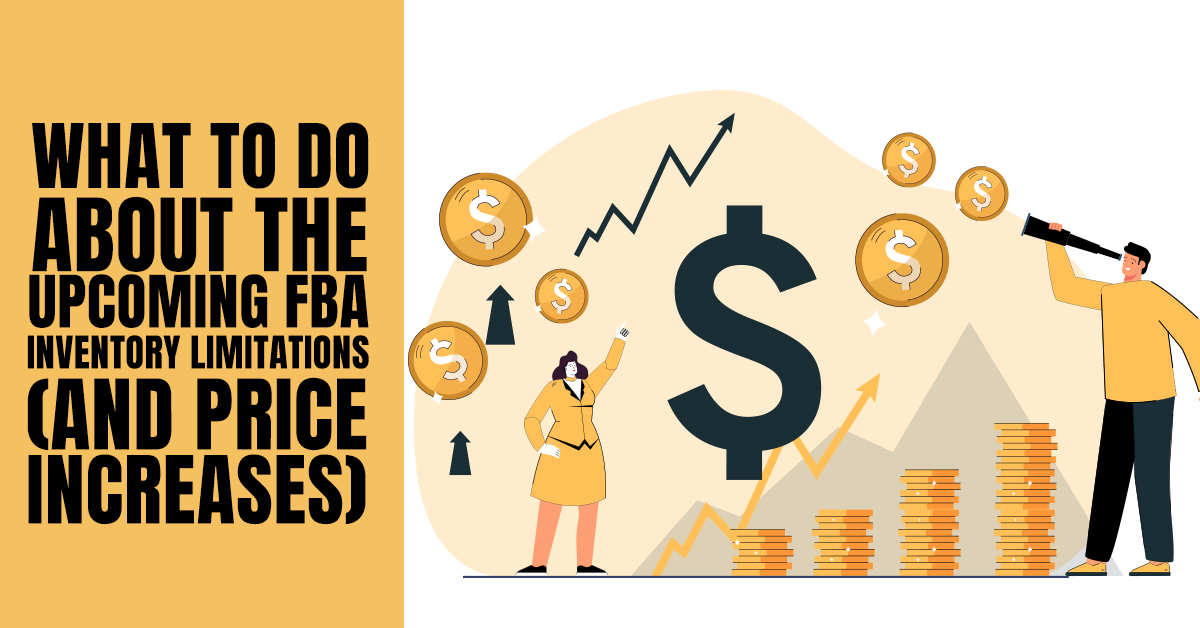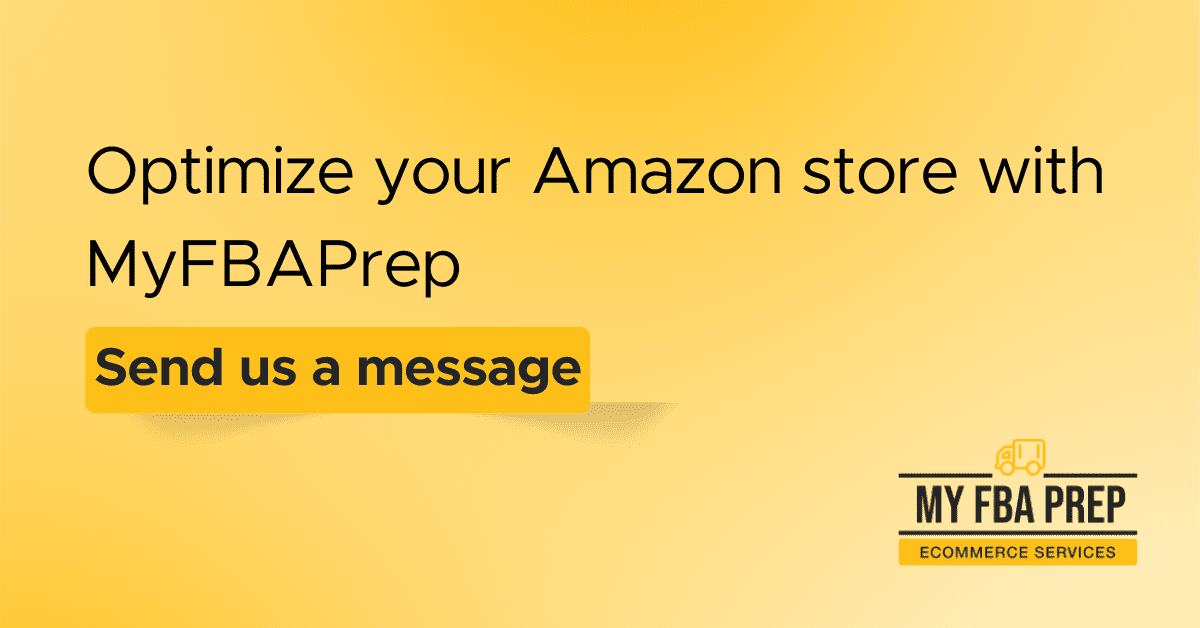
What to Do About the Upcoming FBA Inventory Limitations (and Price Increases)

Just when we thought selling on Amazon couldn’t get more expensive, it has.
Amazon delivered the blow that service fees will be increasing once again. This price hike now joins the inventory limits and rising ad costs sellers must contend with in the most critical selling season and beyond.
To give you an idea, third-party sellers in the US and Canada will have an extra $0.35 tacked on to their bill from the 15th of October 2022. This figure may not seem like much at a glance but can add up fast when selling large volumes and impact your store’s ROI.
So how can you build a profitable Amazon business while navigating the rising costs, reduced space in Amazon’s warehouses, and shaky global supply chain? In this post, we’ll show you how.
Need a way to reduce costs in your Amazon business? Build an efficient fulfillment process with MyFBAPrep.

What’s happening to inventory limits and selling fees?
These days, everywhere you turn, there’s talk of change, and the same goes for selling on Amazon. Knowing what lies ahead for your business will be critical in keeping its growth on course. So let’s break down the two of the latest and most significant shifts on Amazon:
Selling fee rises
Not only are referral fee decreases missing from this year’s Amazon shakeup, but Amazon has also implemented price increases across the board for sellers. Stores on Amazon now have higher costs for services such as FBA, storage (off-peak and peak), labeling, FBA Prep, long-term storage, and removal and disposal solutions.
Some of the most notable changes include:
- Nearly 10.5% price increase for standard and oversized products during the off-peak season (January – September). Prices will remain as is for peak season.
- Small standard-size products have the most significant price hike at an average of 7.5%.
- Small oversize items will pay 2.8% more.
- Medium-sized products now have a 12.1% additional charge.
- Large oversize items have a 7.8% uptick in price.
- Standard-size goods have experienced a 4.8% uptick in selling fees.
Storage space restrictions
Inventory limits
Inventory limits have yoyoed in the last couple of years, with Amazon imposing a much-loathed 200-unit blanket restriction at the height of the pandemic. At present, you’ll receive a warehouse space allowed in cubic meters.
Your inventory limit allocation is Inventory Performance Index (IPI) score-influenced and also depends on the account type you have. Individual seller accounts have a 10 cubic meter cap, and professional sellers have a minimum 25 cubic meter allocation for standard-size, oversize products, clothing, and footwear items. No inventory limits exist for extra-large products, no matter the inventory age or your IPI.
You need an excellent IPI (currently above 400), or you could face restrictions and cuts to your space allowance. However, as mentioned above, there are no inventory limits for extra large products no matter the inventory age or your IPI.
Restock limits
In February 2022, Amazon also changed restock limits from the ASIN level to the storage level. This change means you can now share your restock allowance across ASINs. Your restock limit determines how many replenishment items you can send into Amazon FBA based on your past and predicted sales.
Inventory limits are IPI score-influenced, measured by cubic meters and not by unit. Your warehouse space allowance also depends on your account type (e.g., individual seller accounts have a 10 cubic meter cap, and professional sellers have a minimum 25 cubic meter allocation).
Want to make your Amazon store more profitable? Let MyFBAPrep show you how.
What Amazon’s selling fee hikes and storage restrictions mean for sellers
With the Amazon selling cost hikes and storage adjustments in full swing, it’s normal to feel apprehensive about how they will impact your business. To give you the knowledge needed to come back swinging, let’s explore how the changes will alter your Amazon selling journey:
Product selection will take center stage
While it’s been a long time since sellers could launch average products into the market and make a killing, product selection will now play an even more prominent role.
You’ll need to assess your products based on their ability to deliver high profits and ROI with low competition, reasonable cost per click in ads, and customer satisfaction.
Robust logistics and restocking processes will be your secret weapon
Since you’ll have fewer products in Amazon’s warehouse, the odds of going out of stock will rise. You’ll need a solid system to monitor inventory levels and quickly send replenishments to Amazon’s warehouses.
Also, with the price increases for Amazon’s already costly prep services, you’ll need to rethink high volumes and how you prepare goods for sale.
Killer negotiation skills will be critical to keeping your budget in line
When you combine the Amazon cost increase with the looming recession and global supply chain chaos, every penny will count in the days ahead. Finding suppliers, manufacturers, vendors, and carriers that offer great deals and excellent service will help you keep costs low.
Boosting your revenue and liquidity will be vital to maintain options
Amazon is notorious for changing its requirements, rules, and privileges it gives to sellers. And if Amazon’s track record is anything to go by, these price and storage adjustments are just the beginning.
Therefore you will need to make your business as agile as possible. A great way to do this is by building more liquidity in your store’s finances to increase your speed in responding to Amazon’s changes.
How to overcome Amazon’s changing landscape
Now we’ve set the record straight on the latest changes sweeping the Amazon world; the next question is “how do we tackle these shifts to build a thriving store?”. You’ll need to make a series of strategic moves in tandem. Let’s break them down.
Move your goods into Amazon, stat.
If you take one thing away from this blog post, it should be this; get your inventory into Amazon’s warehouse NOW. This hack will allow you to take advantage of your storage capacity before the changes come into effect. At MyFBAPrep, we’ve had some merchants send all the inventory they were storing with us into FBA to reserve that space.
Revaluate your product portfolio
To maintain healthy profits in the changing Amazon world, it’s essential to upgrade your product portfolio. Eliminate items with lackluster performance. For best results, decide which products you can keep in your portfolio based on factors like:
- Amazon FBA cost
- Product demand
- Item size and weight
From here, implement offers to increase average order value and focus your product sourcing high-margin products. Also, be strategic about where you sell particular products to reduce costs. For example, you could fulfill heavy items from retail locations via customer pickup or ship goods in-house.
Top tip: Shift popular yet low-margin products to be Fulfilled by Merchant or sell on your own website with external fulfillment.
Go multichannel and unify your shipping
If Amazon FBA is proving too expensive, don’t despair as you have options. Many selling sales channels come with their own fulfillment channels. Some viable alternatives to Amazon include:
However, an even better way to approach fulfillment is to pool stock into a fulfillment house and have them prep and ship goods across channels, according to each one’s requirements. This approach will help you circumvent Amazon’s inventory limits and high selling fees.
Get help from an Amazon fulfillment service
One of the simplest and fastest ways to overcome the rising Amazon selling fees is to take control of your shipping and partner with an experienced Amazon prep and pack service.
Your fulfillment provider should help you:
- Organize and send goods to Amazon quickly
- Distribute stock in key locations goods close to demand
- Fulfill orders affordably
- Store replenishment stock
To put this into perspective, MyFBAPrep has an extensive warehouse network with over 50 locations globally, and strategic partnerships with premium freight services.
Tip: Have FBM and FBA stock for your most popular listings to avoid disruption if your Amazon stock runs out.
Maintain a healthy IPI score
To maintain your selling privileges and the perks that come with them, like warehouse space and restock limits, it’s vital to keep your IPI score in tip-top condition. Some ways you can improve your figure include to:
- Pull excess stock from the Amazon warehouse
- Address stranded inventory issues
- Keep your popular ASINs in stock
- Run polls on social media on which products you should launch next
- Get rid of excess inventory in the Amazon warehouse
- Address customer questions and complaints fast
- Implement product upgrades based on reviews to encourage more sales and up your FBA-sell-through rate
- Negotiate product prices so you can pass the saving on to customers
Make income generation a priority
“Money makes the world go around”, especially on Amazon. So look for ways to up cash flow, reduce expenses, and increase your access to liquid capital. There are many ways to make your store more financially stable, here are just a few:
- Run promotions and offers to increase sales velocity
- Save a portion of your profits into a rainy fund
- Liquidate slow-moving and deadstock
- Pay down business debts
- Negotiate your contracts,
- Put it into your agreements to renegotiate fees quarterly or after you hit a specific order volume
- Use a digital wallet to save money on currency conversions
- Get eCommerce funding such as a credit limit or cash advance for peak periods
Wrapping up — Rise above challenges to scale your Amazon store
As we face rising Amazon selling costs and an uncertain global market, diligence will be paramount to building a profitable eCommerce business.
The bottom line is to take advantage of the privileges, be it more storage space or lower fees, for buying your store some more time.
Look for ways to increase your spending efficiency for backend tasks like stock buying and fulfillment. Additionally, use slow burner marketing tactics and assess products from a customer value perspective and ROI viewpoint.
Keep your foot on the selling gas pedal and as you start to see results from your optimizations, save, save, save!
Before you know it, you would have built an eCommerce business that succeeds regardless of the challenges that come its way.


